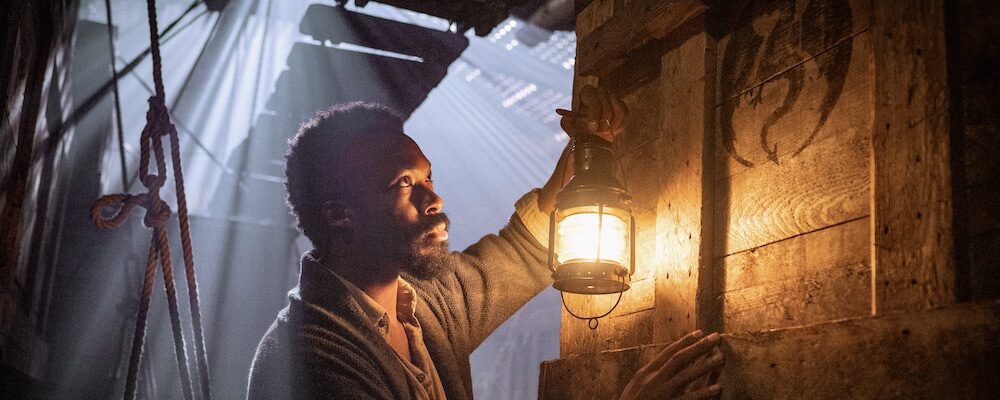‘The Last Voyage of the Demeter’ Sucks the Lifeblood Out of Dracula
Alci Rengifo
The ads for “The Last Voyage of the Demeter” emphasize that it is based on a single chapter out of Bram Stoker’s classic “Dracula.” As with most of these movies, that’s just half of the idea. Director André Øvredal does take the basic situation from the chapter in Stoker’s novel, where the famous vampire gets on a ship headed for England with desires on the wife of the novel’s hero. Once the ship reaches shore, the captain’s log is found detailing how crew members began disappearing. Øvredal’s way of stretching this section out into a two hour movie is by turning it into a murky, dreary screamathon. A whole crew is designed to inhabit the title’s ship, but each one is reduced to nothing more than a snack for the rampaging CGI bat.
The Demeter is first introduced gearing up to leave Romanian shores for England. Captain Eliot (Liam Cunningham) commands the vessel. Onboard is Clemens (Corey Hawkins), a physician who thought he would service Eastern European aristocrats until they realized he is Black. Wojchek (David Dastmalchian) is the first mate, with an intense attachment to his title and the ship. There are also big Olgaren (Stefan Kapicic), the very young Toby (Woody Norman) and devoutly religious Joseph (Jon Jon Briones). Among the big crates being loaded onto the ship, a stowaway is discovered, Anna (Aisling Franciosi). But there is another uninvited passenger as well among the ship’s creaky luggage, Dracula (Javier Botet), who at night emerges from his dirt and maggot-filled crate to go around mauling and munching the crew. He must suck their blood, of course, in order to stay strong for his trip to London.
And that’s basically all there is to “The Last Voyage of the Demeter.” Øvredal is surprisingly lax in building the environment with this movie. He first gained renown in 2010 with “Troll Hunter,” a found footage curiosity with plenty of dark humor. His best movie remains “The Autopsy of Jane Doe,” about two coroners unleashing supernatural terror the more they work on a corpse. In 2019, Øvredal’s “Scary Stories to Tell in the Dark” was produced by Guillermo Del Toro and made up for a clunky script with memorable, nightmarish visuals. What happened here? He seems to think this is a very serious period piece, when it functions more like a slasher flick with an assortment of characters we are given little reason to care about. No motivations are explained, including Dracula’s. Why the vampire is on the boat is up to you to figure out if you haven’t read the book or seen any of the film adaptations.
The plot curiously corners itself with the very root of its idea. If you’re familiar with Stoker’s tale, then you know the crew is doomed from the beginning since Dracula will indeed make it to his destination. Character development should matter even more because we need to feel the tragedy of everyone’s sealed fate. Another option is to jump completely into the blood-soaked spirit of the premise and at least have some comic relief, while taking the violence over-the-top. Øvredal prefers to film the entire movie like a moody dose of depression. During the day most of the color is still drained and everyone sits around looking worried, barking simple one-liners or exposition that goes nowhere. We learn Anna is from a village that has been decimated by Dracula, yet no one on the ship bothers to ask her what the monster onboard is or how to confront it.
As for Dracula, this rendering of the character reduces it to a mere creature feature terror. It’s essentially a CGI version of a big, hairless bat, endlessly leaping out of the dark to shred someone’s neck. The sound mix features lots of howling wind, screaming and snarling. There is none of the eeriness of films like Werner Herzog’s “Nosferatu” remake, where Klaus Kinski looks monstrous but stalks the ship like a quiet specter. Francis Ford Coppola’s “Bram Stoker’s Dracula” went for the operatic approach with gloriously deranged grandeur. Even campy absurdities like “Dracula 2000” had a sense of fun. The structure of “The Last Voyage of the Demeter” amounts to everyone getting some screen time looking sad and anxious, before getting killed by the vampire. There is a raging storm during the climactic fight near the end with Dracula flapping around like one of the dragons from “Game of Thrones.” Maybe an axe will kill him, or gunfire. By the end we don’t care, even when bite victims rise back from the dead only to be quickly burned to a crisp by a sunrise. Much of the action is difficult to clearly see, buried under digital storms and dark lighting where you have to squint to see what’s going on, especially when Dracula appears. It’s easier to see through a car windshield on a rainy day.
Adding to the tiresomeness is how the very final scene still has the gall to suggest this might just be the beginning of yet another franchise. It involves a pub and the not shocking revelation that Dracula is still alive, yet somehow walking around 19th century London with the exact same hairless vampire visage he sported on the ship, except now wearing a top hat. If a sequel is made, then it should strive to leave the audience more entertained than depressed. Øvredal has proven before to be an excellent stylist who can create dread and atmosphere. Hopefully this was just an odd attempt at Hollywood formula that will lead to a stronger return. “The Last Voyage of the Demeter” will certainly not be the last time Dracula is resurrected for a movie, but this take on the old monster has all the lifeblood sucked out of it.
“The Last Voyage of the Demeter” releases Aug. 11 in theaters nationwide.

